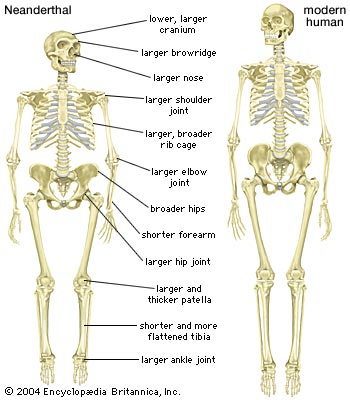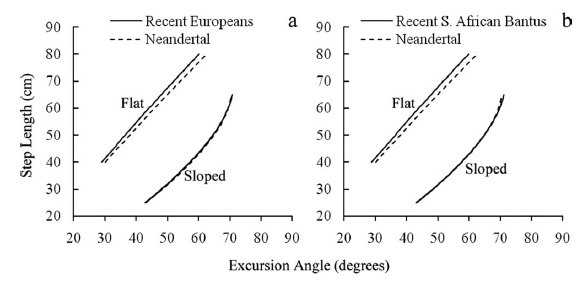Neanderthals had shorter legs than their Homo sapiens contemporaries, leading many to believe that the locomotion of the former was less efficient (basically, they have to take more steps to traverse a certain distance). But a new study, performed by researchers at the John Hopkins School of Medicine, questions this notion.
What’s new in this study is that it takes the terrain into account. Whereas previous studies looked only at flat land, this one considered sloped, mountainous terrain more like the environment in which Neanderthals could be found. The colder climate they were exposed to, led to a ‘compaction’ of the Neanderthal body (less surface area, thus less loss of body heat) (see figure 1).

Figure 1: Comparison between Neanderthal and modern human.
Using a mathematical model, the authors found that Neanderthals were not less efficient than their long-limbed cousins (see figure 2) when walking across rugged terrain.

Figure 2: Step length related to the excursion angle of the hip on flat and sloped terrain, for Neanderthals and (a) recent Europeans, and (b) South African Bantus.
(Source: Higgins and Ruff, 2011)
The researchers did not stop there, however. They investigated whether this finding could be extrapolated to other mammal species living both on flat terrain and in rugged, mountainous environments. To do this, they applied their analysis to 78 bovid species. The results provided support for the notion that shorter legs (likely due to a colder climate) are not a disadvantage in hilly territory. Even within closely related species, the ones in the mountains have shorter legs than those on flat land.
The authors conclude:
Thus, while limb truncation in Neandertals may have been related to climatic adaptation, it may not have presented a selective disadvantage in terms of locomotion on rugged terrain. An analogous comparison between a large sample of bovids inhabiting a diverse range of environments also supports the advantage of shortened distal segments for locomotion on mountainous terrain regardless of climate. Together these findings advocate for more consideration of the effects of terrain on locomotion and limb proportions in humans and other animals.
Reference
Higgins, R.W. and Ruff, C.B. (2011). The Effects of Distal Limb Segment Shortening on Locomotor Efficiency in Sloped Terrain: Implications for Neandertal Locomotor Behavior. American Journal of Physical Anthropology. 146, pp. 336 – 345. doi:10.1002/ajpa.21575.



Comments